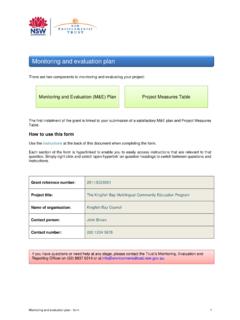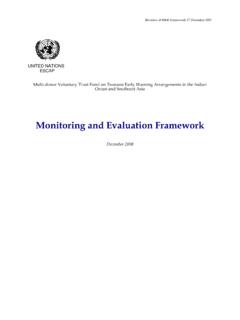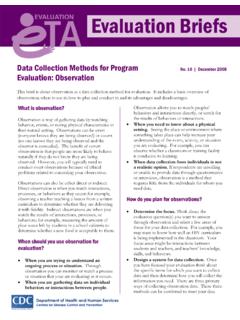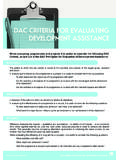Transcription of Toolkit for Monitoring and Evaluation Data Collection
1 Toolkit for Monitoring and Evaluation data Collection Pacific Women Shaping Pacific Development Support Unit November 2017 Toolkit for Monitoring and Evaluation data Collection i Preferred citation: Cardno (2017) Toolkit for Monitoring and Evaluation data Collection , Pacific Women Shaping Pacific Development Cardno Emerging Markets For further information about this plan, please contact: Pacific Women Contractor Representative Cardno Emerging Markets Pacific Women Ph. +61 3 8415 7777 2017 Cardno. Copyright in the whole and every part of this document belongs to Cardno and may not be used, sold, transferred, copied or reproduced in whole or in part in any manner or form or in or on any media to any person other than by agreement with Cardno. This document is produced by Cardno solely for the benefit and use by the client in accordance with the terms of the engagement.
2 Cardno does not and shall not assume any responsibility or liability whatsoever to any third party arising out of any use or reliance by any third party on the content of this document. This publication has been funded by the Australian Government through the Department of Foreign Affairs and Trade. The views expressed in this publication are the author s alone and are not necessarily the views of the Australian Government. Toolkit for Monitoring and Evaluation data Collection ii Contents Background .. 1 Introduction to the Toolkit .. 1 Purpose of the 2 Use of the Toolkit in an Evaluation led approach .. 2 How will data gathered by implementing partners be used? .. 2 Where are we in the program cycle? .. 2 M&E Theory and Other Considerations .. 3 Principles and ethics for M&E data Collection and reporting.
3 4 Gender sensitive Monitoring and Evaluation 7 Considering disability .. 9 M&E and its relationship to data Collection and reporting ..11 Further information about each column in Sample M&E Plan 1 .. 1 Sample M&E Plan 2 .. 2 Developing a baseline .. 2 More information and sector specific Monitoring and Evaluation frameworks .. 4 How and from whom will your M&E data be collected? .. 5 Qualitative v Quantitative .. 5 Approaches and Sample Formats .. 6 data Collection methods where do I start? .. 6 Participant attendance records ..10 Worker journal ..11 Guide for simple surveys ..14 Client satisfaction survey ..17 Key stakeholder satisfaction survey ..18 Before / after training survey ..20 Training / workshop Evaluation ..21 Census questions on disability endorsed by the Washington Group.
4 24 Exit interview form ..24 Participant tracking form ..25 Semi-structured interview guide ..26 Guide for running focus groups ..29 Guide for running workshops ..33 Guide for community meetings ..35 Direct observation guide ..37 Media Monitoring guide ..39 Guide for developing case study stories and vignettes ..41 Sampling ..43 Other data Collection Methods .. 46 Most significant change ..46 Participatory learning and action ..47 Digital story telling ..47 In-depth case studies ..47 Contribution analysis ..48 Network mapping ..48 Measuring advocacy and policy change ..48 Power analysis ..48 Partnership, alliance and coalition tools ..49 Toolkit for Monitoring and Evaluation data Collection iii data Analysis, Reflection and 49 data entry and recording ..49 data analysis.
5 50 Internal learning events ..55 Reporting ..57 Tables and Figures Table 1 data Collection and potential ethical issues and considerations .. 6 Table 2 Example Monitoring and Evaluation plan .. 3 Table 3 When and how to use each tool .. 7 Table 4 Participant attendance sheet .. 11 Table 5 Example journal format .. 13 Table 6 Example client satisfaction survey .. 17 Table 7 Example survey format .. 19 Table 8 Example before and after survey .. 21 Table 9 Example training workshop Evaluation .. 22 Table 10 Example exit interview .. 25 Table 11 Example participant tracking form .. 26 Table 12 Sample focus group discussion questions .. 31 Table 13 Example communication education session .. 38 Table 14 Basic media Monitoring strategies to consider .. 40 Table 15 Media Monitoring Collection .. 41 Table 16 Example matrix.
6 52 Table 17 Evaluation questions .. 52 Table 18 Learning event plan and agenda .. 56 Table 21 activity update .. 58 Figure 1 Program cycle .. 3 Figure 2 Principles and ethics .. 4 Figure 3 Triple jeopardy of discrimination .. 10 Figure 4 Performance stories .. 13 Figure 5 Before and after comparison .. 2 Figure 6 Tool selection .. 7 Figure 7 Summary of qualitative and quantitative data methods .. 9 Figure 8 Mapping journal entries .. 12 Figure 9 Example of Likert Scale .. 16 Figure 10 Post workshop Evaluation dartboard activity .. 23 Figure 11 Semi-structured 27 Figure 12 Oxfam s organisational strengthening module .. 42 Toolkit for Monitoring and Evaluation data Collection iv Figure 13 Sample as part of the target population .. 43 Figure 14 Random sampling .. 44 Figure 15 Stratified sampling.
7 44 Figure 16 Other sampling methods .. 45 Figure 17 Determine sampling size .. 46 Figure 18 Oxfam data analysis .. 50 Figure 19 Oxfam module .. 51 Figure 20 Example data sheet .. 53 Figure 21 Example data code .. 53 Toolkit for Monitoring and Evaluation data Collection v Acronyms DFAT Department of Foreign Affairs and Trade MELF Monitoring , Evaluation and Learning Framework VfM Value for Money VAW Violence Against Women Toolkit for Monitoring and Evaluation data Collection 1 Background Pacific Women Shaping Pacific Development (Pacific Women) is a $320 million, 10-year program (2012 2022) focused on enabling women and men across the 14 Pacific Island Forum countries to improve the political, social and economic opportunities for women. It reflects the Government of Australia s commitment to work for improved equality and empowerment of women.
8 The outcomes sought by Pacific Women include: Women, and women s interests, are increasingly and effectively represented and visible through leadership at all levels of decision-making (leadership and decision making) Women have expanded economic opportunities to earn an income and accumulate economic assets (women s economic empowerment) Violence against women is reduced and survivors of violence have access to support services and to justice (ending violence against women) Women in the Pacific will have a stronger sense of their own agency, supported by a changing legal and social environment and through increased access to the services they need (enhancing agency) In addition to the above outcomes, Pacific Women has two objectives. These include: By the end of the first three years of the program, the capacity, resources and relationships are established and action in key result areas is evident across the country and regional program activities.
9 By the end of Year Six, joined up services and action, independent of but informed by Pacific Women will be evident in all 14 countries. Pacific Women is implemented through work at the country and regional level. Country plans have been developed to represent locally relevant responses and starting points for change towards the key intended outcomes. Regional and multi-country activities have been designed to address common issues across the region or sub-region and to complement and build on country specific activities. To support program management, a Pacific Women Support Unit has been established in Fiji, with a national sub-office in PNG. The Support Unit's role is to provide technical, administrative and logistical support to the Department of Foreign Affairs and Trade s (DFAT) bilateral and regional Pacific Women teams and to Pacific Women s implementing partners.
10 Introduction to the Toolkit Pacific Women s M&E system operates at various levels. This includes the program level, the country level and the activity level. Each separate level has its own cycle of planning, Monitoring , Evaluation and reporting. These cycles together combine to form the Pacific Women M&E system. The M&E system is made up of the following components: A program Monitoring , Evaluation and Learning Framework (MELF); Pacific Women Country Plan MELFs and implementing partner M&E plans. A Knowledge Management System database that is used to collect and analyse data collected by implementing partners. Pacific Women program reporting, which includes Pacific Women Six-Monthly Program Progress Report, an Annual Pacific Women Progress Report and implementing partner project reporting (either six-monthly or annual, dependant on partner and project size).







